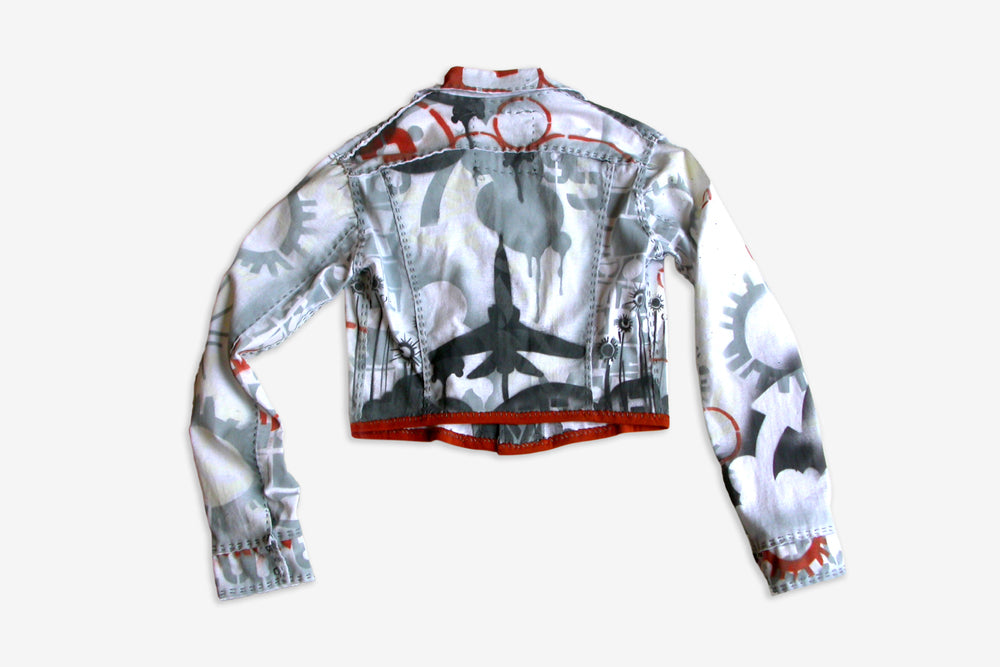From 2005 to 2006, Michi Meko, an artist and Shoals native, works with a range of collection stencils to airbrush graffiti-style patterns to a selection of Project Alabama garments. These garments are then hand-sewn and embellished in collaboration with a growing number of local artisans.
Natalie remembers Michi, as a vision of summertime: in the basement stenciling area at the Lovelace Crossroads production house, doors wide open, boombox turned up, stencils out, sweat dripping, creativity exploding, and painted t-shirts hanging on the clothes lines, both inside and out.
The conversation below with Michi Meko and the Alabama Chanin team occurred via email on September 23rd, 2021. We are grateful to Michi for our shared work and collaborations and for taking the time to write about it all.
Alabama Chanin: What is your earliest memory of Natalie and/or Alabama Chanin?
Michi Meko: I think I had already moved from Florence to Atlanta by the time I had heard of Natalie. I was first introduced to her work by my very close friend and partner in crime, Shannon Schmafedlt. She was working at a house factory. I remember her being super stoked about the project and the garments that were being made. She explained the ladies sewing and how it was kinda old school but like right now. I remember her showing me these t-shirts that had been remixed and deconstructed into what looked like corsets. I thought they were really FRESH. I had never seen anything like it. The stitching was out front and not hidden away. I liked the way that the labor was part of the aesthetic. It was very intentional and just pleasant to see but still raw! It felt really punk. So I met the work before I met the designer. Once I met the designer, I was totally enamored.
AC: Do you have a favorite Alabama Chanin piece, collection, or collaboration? If so, why does this stand out to you?
MM: I would have to say that the garments that I worked on were my favorites. The Hollywood Inn garment was a fave. It had like these gold chains on it but one of my simple patterns within the collaborations. Also this Pink Poodle type dress that I worked on. It felt like the 50s but 90s Boom Bap Hip Hop. There was also a season that used these greys and oranges with gear-like shapes that I collaborated with during the early Alabama, I still use those colors in my current work. I own a very early t-shirt that has a skull pattern that I love. It's signed and numbered. I've recently been eyeballing the scarves and the down items.
AC: What do you feel is Alabama Chanin’s most enduring quality? We want to know what comes to mind first and what resonates with you?
MM: For me, it's the risk taking and sticking to her guns. To treat the garments as narratives. Like short stories we can all wear. The idea that everything doesn't have to be this huge operation that mass produces quickly. I admire that there was, or is, no rush to relocate to New York or LA but that this part of Southern Culture could be an export to the world from a small hand making factory in Alabama. I have in many ways taken this approach in my studio practice.
AC: As our industry evolves, what do you hope to see for the future? Where do you see Alabama Chanin in this vision?
MM: I think from the very beginning Alabama Chanin was futuristic. I simply say stay the course. The Akan people call it Sankofa. I think by looking back to go forward, and slowing the pace in a fast-driven, immediate culture makes the work more futuristic and ahead of whatever trends may come and go. The vision doesn't seem concerned with any of that. So for me it's a follow your bliss kind of thing.
AC: Finally, is there anything you’d like to say to Natalie or the Alabama Chanin team?
MM: Thank you for being an inspiration and taking a chance on a very early artist like myself.
Explore Michi Meko’s incredible art and work, and follow along @michimeko.
Slide 1: Painted cropped jacket from the Project Alabama and Michi Meko Collaboration, 2005, photo by Reyes Melendez
Slide 2: Portrait of artist Michi Meko, photograph courtesy of Michi Meko; Painted Corset with beading and applique from the Project Alabama and Michi Meko collaboration
Slide 3: Detail of "Prepare" by Michi Meko, photograph courtesy of Michi Meko
Slide 4: Clothespins on a line in Project Alabama’s stenciling department, where painted garments would hang to dry before departing to their new homes, photograph by Robert Rausch
Slide 5: Painted unisex T-shirt with reverse appliqué from the Project Alabama and Michi Meko Collaboration
Slide 6: "Season FALL" by Michi Meko, photograph courtesy of Michi Meko
Slide 7: Production of “Hollywood Inn” T-shirts from the Project Alabama and Michi Meko Collaboration, photograph by Robert Rausch; Corset with beading and appliqué from the Project Alabama and Michi Meko Collaboration
